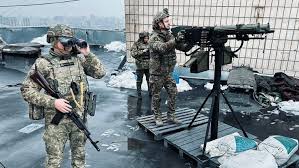
Published September 7, 2025
Russia is projected to deplete its supply of anti-drone missiles, specifically the Pantsir systems, by February 2026, according to military experts. These missiles have been rapidly expended in defense against frequent Ukrainian drone attacks, particularly targeting oil refineries. The high usage rate has outpaced Russia’s ability to replenish them, leading to concerns that Moscow may need to stretch its air defenses thinner or leave strategic targets vulnerable.
Despite efforts to ramp up missile production, UK officials believe it could take months for these measures to have a significant impact. Dr. Jack Watling from the Royal United Services Institute (RUSI) suggests that this shortage could provide Ukraine with a “window of opportunity” to intensify pressure on Russian infrastructure. However, analysts caution against overconfidence, noting that Russia has historically managed to rebuild depleted missile stocks. It’s important to note that this shortage does not affect Russia’s longer-range systems, such as the S300 and S400, which are used to intercept cruise and ballistic missiles.
This development underscores the evolving dynamics of the conflict, highlighting the strategic importance of anti-drone capabilities and the potential vulnerabilities that can arise from their depletion.
👥 Public/Political Reactions
The anticipated depletion of Russia’s anti-drone missile supply, particularly the Pantsir systems, by February 2026 has elicited varied reactions from both Russian officials and international observers.
🇷🇺 Russian Official Response
In response to the growing vulnerability of its air defenses, Russia has initiated measures to bolster its missile production. However, UK intelligence officials suggest that these efforts may take several months to yield significant results. Notably, President Vladimir Putin was recently seen accompanied by a security officer carrying a Yolka kinetic interceptor during a public appearance, highlighting heightened concerns over potential Ukrainian drone attacks.
🌍 International and Public Reactions
-
Ukraine: Ukrainian officials view the impending shortage as a strategic opportunity to intensify drone strikes on Russian infrastructure. President Volodymyr Zelenskyy continues to advocate for increased international support to exploit this window effectively.
-
United Kingdom: Dr. Jack Watling of the Royal United Services Institute (RUSI) notes that the depletion of Russia’s short-range anti-drone capabilities could provide Ukraine with a temporary advantage. However, he cautions that Russia has historically managed to replenish its missile stocks after past shortages.
-
United States: While specific reactions to the missile shortage are not detailed in the available sources, the U.S. has previously expressed concerns over Russia’s military capabilities and has provided support to Ukraine in the form of arms packages.
 Resulting Effects
Resulting Effects
Here’s a breakdown of the resulting effects of Russia potentially running out of short-range anti-drone missiles like the Pantsir systems:
1. Increased Vulnerability of Strategic Assets
-
Critical infrastructure, such as oil refineries, power plants, and military depots, could face more frequent and effective drone attacks from Ukraine.
-
With fewer missiles available, Russia might have to prioritize which targets to defend, leaving others exposed.
2. Operational Strain on Russian Air Defenses
-
Russia may need to stretch existing air defense resources thinner, relying on longer-range systems like the S-300 and S-400 for roles they weren’t primarily designed for.
-
This could reduce overall defensive efficiency and reaction times, potentially allowing more drones to penetrate defended zones.
3. Strategic Advantage for Ukraine
-
A temporary “window of opportunity” could allow Ukraine to intensify drone attacks and disrupt Russian supply chains and military infrastructure.
-
Increased pressure might force Russia to divert resources from offensive operations to defensive measures.
4. Pressure on Russian Military Production
-
The shortage highlights challenges in Russia’s domestic production and supply chain for advanced missile systems.
-
Accelerated production could strain resources, while any delays prolong vulnerabilities.
5. Psychological and Political Effects
-
The shortage may embolden Ukrainian forces and supporters internationally.
-
Russian public and political perception could be affected, with the appearance of weakened military capability.
6. Potential Long-Term Adaptation
-
Russia may eventually replenish missile stocks or develop new counter-drone tactics, including drones targeting drones or electronic warfare solutions.
-
This underscores that the current shortage is a temporary but significant tactical vulnerability rather than a permanent strategic collapse.
🔮 Future Outlook
1. Short-Term Outlook (Next 6–12 Months)
-
Increased Ukrainian Drone Effectiveness: Ukraine is likely to exploit the temporary gap in Russia’s air defenses to intensify drone strikes on key infrastructure.
-
Strained Russian Defenses: Russia may need to redeploy long-range systems (S-300/S-400) to cover short-range gaps, potentially reducing efficiency against cruise and ballistic missiles.
-
Production Ramp-Up: Efforts to produce more Pantsir missiles may begin to mitigate shortages, but significant results could take months.
2. Medium-Term Outlook (1–2 Years)
-
Russian Adaptation: Russia is likely to replenish stocks of anti-drone missiles and possibly accelerate development of new, more advanced counter-drone systems.
-
Ukrainian Innovation: Ukraine may continue refining drone tactics, including swarming, low-cost drones, and electronic warfare to bypass defenses.
-
Continued Infrastructure Risk: Key military and industrial sites may remain at risk until Russia stabilizes its air defense capacity.
3. Long-Term Outlook (Beyond 2 Years)
-
Technological Evolution: The conflict may drive further innovation in both drone and counter-drone technologies, shaping future warfare.
-
Strategic Balance: Short-term vulnerabilities could influence Russia’s operational strategy, but over time, restored missile stocks and adaptation may reduce the tactical advantage for Ukraine.
-
Political Implications: Repeated exposure of Russian weaknesses may affect domestic morale and international perceptions, influencing foreign policy and aid to Ukraine.
 Bottom Line:
Bottom Line:
The reported depletion of Russia’s short-range anti-drone missiles, particularly the Pantsir systems, underscores the evolving dynamics of modern warfare, where drones and counter-drone technologies play a critical role. In the short term, this shortage creates a tactical vulnerability for Russia, giving Ukraine a window to intensify attacks on key infrastructure and disrupt supply chains.
However, historical patterns suggest that Russia is likely to replenish its missile stocks and adapt its defense strategies over time. While the shortage exposes temporary weaknesses, it does not represent a permanent collapse of Russian air defenses. The situation highlights the strategic importance of resource management, technological innovation, and the ongoing arms race between drone offensive capabilities and anti-drone systems.
Ultimately, this development reflects a shifting battlefield in which air defense sustainability, drone strategy, and rapid adaptation will continue to shape the course of the conflict.
SOURCES: THE SCOTTISH SUN – WARHEAD WOES Humiliation for Putin as Russia set to RUN OUT of anti-drone missiles in months giving Ukraine ‘window of opportunity’





Be the first to comment